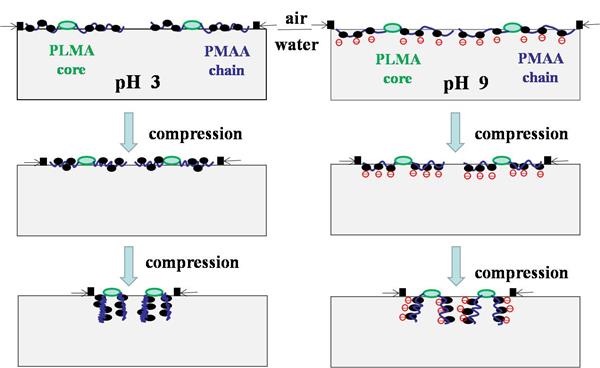23.【Colloids Surf. A】Influences of subphase pH and temperature on the interfacial aggregation behavior of poly(lauryl methacrylate)-block-poly(methacrylic acid)
writer:Kun Jiang, Gangyao Wen*, Athanasios Skandalis, Stergios Pispas, Yanping Ding, Hongxu Chen
keywords:Langmuir-Blodgett film; block copolymer; PLMA-b-PMAA; pH-responsiveness; subphase pH
source:期刊
specific source:Colloids and Surfaces A: Physicochemical and Engineering Aspects 2021, 620, 126528.
Issue time:2021年
We previously reported that poly(acrylic acid) (PAA) blocks at the air/water interface spontaneously immersed into water at high pH before monolayer compression. To investigate the influence of the hydrophobic methyl groups in poly(methacrylic acid) (PMAA) blocks, in this work, subphase pH and temperature effects on the aggregation behaviors of two pH-responsive amphiphilic diblock copolymers poly(lauryl methacrylate)-block-poly(methacrylic acid) (PLMA-b-PMAA) (PLMA49%-PMAA and PLMA61%-PMAA, composition in weight percent) at the air/water interface were studied. The surface pressure-molecular area isotherms of the two copolymers move to small mean molecular area (mma) as subphase pH increases and a quasi-plateau exists under various subphase conditions, which is quite different from its absence in our previous PAA-containing block copolymer system. The quasi-plateau is attributed to the pancake-to-brush transition as non-ionized PMAA chains submerge into subphase upon monolayer compression. Under acidic condition, PMAA chains of the two copolymers are almost non-ionized, the compression and expansion isotherms show large hysteresis phenomena. Under neutral and alkaline conditions, the isotherms show small hysteresis, which is because more ionized PMAA chains immerse in subphase before compression. The isotherms shift toward small mma with increasing temperature under neutral and alkaline conditions, whereas a slight shift back to large mma is observed under acidic conditions. The plateau surface pressures of the two PLMA-b-PMAA copolymers decrease with increasing temperature under different pH conditions, which is because the micelles move more freely and easier to rearrange at high temperature. The plateau surface pressures of PLMA49%-PMAA are higher than those of PLMA61%-PMAA under the corresponding conditions due to the higher PMAA content in the former. The initial Langmuir-Blodgett (LB) films of the two copolymers transferred under different pH conditions at various temperatures exhibit isolated circular micelles because of the steric hindrance and/or repulsive interactions among the long PMAA chains. Furthermore, temperature has almost no effect on the micelle core diameters of the initial LB films.

Artical address: https://doi.org/10.1016/j.colsurfa.2021.126528.
Share Link: https://authors.elsevier.com/a/1cv1r3IywUI1l8 (before June 02, 2021)